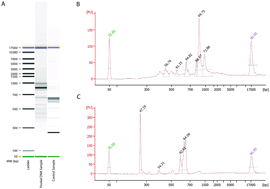High-throughput identification of putative receptors for cancer-binding peptides using biopanning and microarray analysis†
Abstract
Phage-display

Maintenance work is planned for Wednesday 1st May 2024 from 9:00am to 11:00am (BST).
During this time, the performance of our website may be affected - searches may run slowly and some pages may be temporarily unavailable. If this happens, please try refreshing your web browser or try waiting two to three minutes before trying again.
We apologise for any inconvenience this might cause and thank you for your patience.
* Corresponding authors
a
Department of Radiation Oncology, Mallinckrodt Institute of Radiology, and Siteman Cancer Center, Washington University School of Medicine, 4511 Forest Park, Saint Louis, MO, USA
E-mail:
dhallahan@radonc.wustl.edu
b Department of Biochemistry, Washington University in St. Louis, Saint Louis, MO, USA
Phage-display

 Please wait while we load your content...
Something went wrong. Try again?
Please wait while we load your content...
Something went wrong. Try again?
 Fetching data from CrossRef.
Fetching data from CrossRef.
This may take some time to load.
Loading related content
